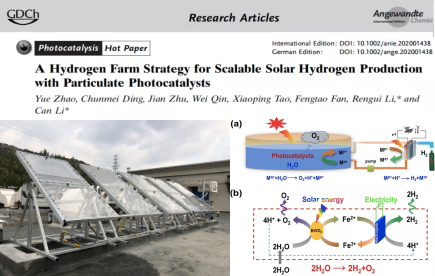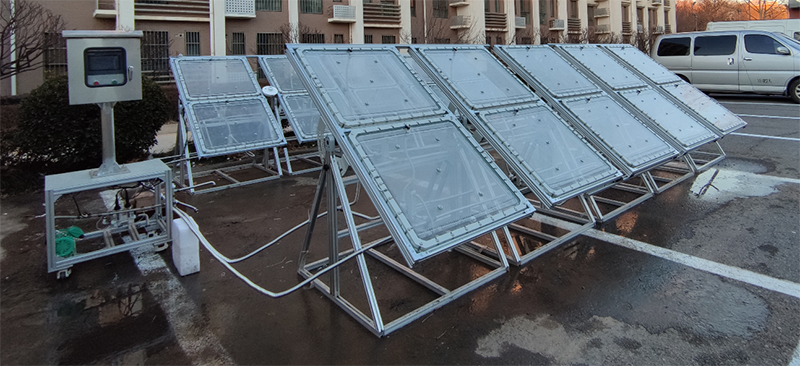Creating original content is not an easy task. If you intend to republish this article, please contact the staff and include the source information in the reproduced article. Otherwise, it will be treated as a copyright violation!
Hydrogen, the oldest element in the universe, existed even before the birth of the sun. Hydrogen is also the most abundant element in the cosmos, with hydrogen atoms constituting 88.6% of all the atoms in the universe. Hydrogen is not only found in water; the sun's energy also originates from hydrogen, and hydrogen energy might become the primary energy source for the Earth in the future.
Green hydrogen is produced using renewable energy sources such as solar and wind energy. It can be generated through the process of 'green electricity' to produce 'green hydrogen,' or by using photocatalytic water splitting to generate hydrogen.
'Green electricity' involves generating power using renewable sources like wind, solar, water, and geothermal energy. Subsequently, green hydrogen (H₂) is produced through catalytic water electrolysis using this 'green electricity,' resulting in extremely low carbon emissions.
Since China's 'Dual Carbon' goal was introduced last year, green hydrogen has ignited a wave of enthusiasm domestically. Electrolytic hydrogen production offers features like environmental friendliness, production flexibility, and high purity, enabling it to fulfill the demand for high-purity hydrogen gas.
Where Does Large-Scale, Low-Cost, and Clean Green Hydrogen Come From? - Photocatalytic Water Splitting for Hydrogen Production
Academician Li Can's team, consisting of researchers from the Chinese Academy of Sciences and the School of Chemistry and Materials Science at the University of Science and Technology of China, utilizes electric power generated from renewable energy sources such as solar energy to perform water electrolysis and produce hydrogen. They also synthesize methanol and other green liquid fuels by combining carbon dioxide with hydrogen for ease of storage and transportation.
“Hydrogen Farm” project aims to solve two key challenges: first, how to achieve efficient water oxidation photocatalysis and second, how to suppress reactions between oxidized and reduced species generated on the surface of nano photocatalysts[1].
Perfectlight Technology, commissioned by Academician Li Can's team, developed a direct solar array-type flat-plate photochemical reaction system with a reaction area of 5 m2. The system utilizes solar energy photocatalytic technology for photochemical reactions. The system employs an array arrangement, with photocatalysts coated on the surface of the reaction system, allowing for direct exposure to sunlight from outside to carry out photocatalytic water splitting reactions.
Direct Solar Array-Type Flat-Plate Photochemical Reaction System can monitor parameters like irradiance, ultraviolet radiation, total irradiation, solution pH level, Oxidation-Reduction Potential (ORP), and more. It monitors the inlet and outlet of the reaction system, intermediate temperature, and environmental temperature. The support structure can be adjusted within a range of 20 to 70 degrees for optimal effective light angles. Additionally, it possesses IP5 waterproof rating, weather resistance, and resistance to temperature impact, making it suitable for outdoor use.

Figure 5. Perfectlight Technology's Direct Solar Array-Type Flat-Plate Photochemical Reaction System
But the source of green hydrogen is not limited to the electrolysis of water method.
Professor Kazunari Domen's team at the University of Tokyo, Japan[2], reported the use of aluminum-doped strontium titanate (SrTiO₃:Al) photocatalysis for water splitting to produce hydrogen. The process was scaled up in a 1 m2 flat-panel reactor system and successfully demonstrated with a 100 m2 flat-panel reactor array, achieving a maximum solar-to-hydrogen (STH) efficiency of 0.76%. While the hydrogen production efficiency is relatively low, this research suggests the feasibility of large-scale photocatalytic water splitting and gas collection separation.
The PLR-SPR100 solar water splitting reaction device developed by Perfectlight Technology is specifically designed for large-area photocatalytic water splitting for hydrogen production research. The device immobilizes the photocatalyst on the upper part of the reactor. Multiple reactors are connected in parallel. The liquid flows from the lower end to the upper end of the reactor through the action of a mechanical pump. The liquid passes through the reactor, is directly irradiated by sunlight, and the photocatalytic reaction system produces hydrogen. The hydrogen generated by photocatalytic water splitting is carried to the gas-liquid separation device. Inside the gas-liquid separation device, the liquid continues to flow back to the reactor. The hydrogen gas produced by the photocatalytic water splitting escapes from the upper end of the gas-liquid separation device. The hydrogen gas production is measured and recorded by a mass flow meter, and the hydrogen produced by the photocatalytic water splitting reaction is stored in a gas collection device.

Figure 6. Perfectlight Technology PLR-SPR100 Solar Water Splitting Reaction Device
Hydrogen energy is an important direction for future energy technology revolution and industrial development. It plays a crucial role in achieving "carbon peaking" and "carbon neutrality," and it is also a key driver for the green and low-carbon transformation of the energy system. The development of green hydrogen is of utmost importance, and Perfectlight Technology will contribute to its advancement in the field of photocatalysis and related research.
The above content is a translation and summary based on reference materials. As my proficiency is limited, any errors are kindly welcomed to be corrected!
[1] Zhao Yue, Li Rengui*, Li Can*, et. al. A Hydrogen Farm Strategy for Scalable Solar Hydrogen Production with Particulate Photocatalysts[J]. Angew, 2020, 132(24), 9740.
[2] Nishiyama, Hiroshi, Yamada, Taro, Kazunari Domen*, et. al. Photocatalytic Solar Hydrogen Production from Water on a 100 m2-scale[J]. Nature, 2021, 598, 304.